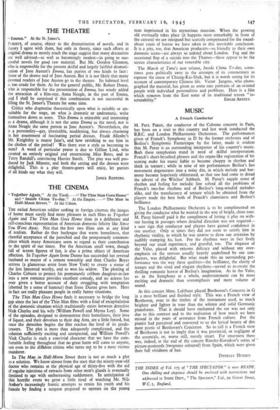MUSIC
A French Conductor M. PAUL. PARRY,- the conductor of the Colonne concerts in Paris, has been on a visit to this country and last week conducted the B.B.C. and London Philharmonic Orchestras. The performances given of Franck's Symphony in D by the former orchestra and of Berlioz's Symphonic Fantastique by the latter made it evident that M. Paray is an outstanding interpreter of his country's music. Both these symphonies stand in need of skilful interpretation. Franck's short-breathed phrases and the organ-like registration of his scoring make his music liable to become choppy in rhythm and thick in texture ; while in nine of ten performances Berlioz's last movement degenerates into a noisy din, in which melody and har- mony become hopelessly obliterated, so that one had come to dread the advent of the Witches' Sabbath. M. Paray's supple sense of rhythm and feeling for melodic line solved all the problems of Franck's two-bar rhythms and of Berlioz's long-winded melodies alike, and the translucency of texture which he obtained from the players made the best both of Franck's clumsiness and Berlioz's brilliance.
The London Philharmonic Orchestra is to be complimented on giving the conductor what he wanted in the way of bright, clean tone. M. Paray himself paid it the compliment of letting it play on with- out fussing in passages where detailed direction was not required— a sure sign that conductor and players have gained confidence in one another. Only at times they did not seem to satisfy him in rhythmic vitality, to which he was unwise to draw our attention by audibly stamping his foot. For the rhythms were in fact lively beyond our usual experience, and graceful, too. The elegance of the Valse, played with extreme delicacy and without any over- emphasis on the stresses usually heavily underlined by our con- ductors, was delightful. But what made this an outstanding per- formance was the way these qualities—the brilliance, the clarity of texture and the vivid and elegant rhythms—served to re-create the thrilling romantic horror of Berlioz's imagination. As in the Valse, so in the Symphony as a whole, understatement can be more exciting and dramatic than overemphasis and mere volume of sound.
At this concert Mine. Lefebure played Beethoven's Concerto in G in a most brilliant and finished style. This was a French view of Beethoven, even to the timbre of the instrument used, so much brighter and lighter in tone than the solemn and solid Germanic pianofortes. That it should have enchanted the ear was not only due to this contrast and to the realisation of how much we have missed in the years of severance from French culture. For the pianist had perceived and conveyed to us the lyrical beauty of this most poetic of Beethoven's Concertos. So to call it a French view of Beethoven is not to imply that it was provincial, or negligent of the essentials, or, worse still, merely smart. For smartness there was, indeed, at the end of the concert Rimsky-Korsakov's series of picture-postcards (twopence coloured) from Spain, which were given their full vividness of hue.
DYNELEY HUSSEY.


























 Previous page
Previous page